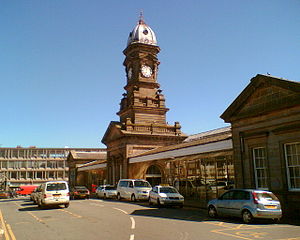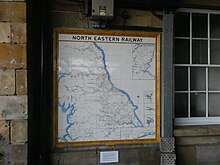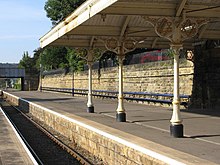Scarborough railway station
 The entrance to the station | |
| General information | |
| Location | Scarborough, North Yorkshire England |
| Coordinates | 54°16′47″N 0°24′20″W / 54.279800°N 0.405500°W |
| Grid reference | TA039883 |
| Managed by | TransPennine Express |
| Platforms | 5 |
| Other information | |
| Station code | SCA |
| Classification | DfT category C1 |
| History | |
| Opened | 1845 |
| Passengers | |
| 2018/19 | |
| 2019/20 | |
| 2020/21 | |
| 2021/22 | |
| 2022/23 | |
Listed Building – Grade II | |
| Feature | Scarborough railway station |
| Designated | 8 June 1973 |
| Reference no. | 1243452[1] |
| Notes | |
Passenger statistics from the Office of Rail and Road | |
Scarborough, formerly Scarborough Central, is a Grade II listed[1] railway station serving the seaside town of Scarborough, North Yorkshire. It lies 42 miles (68 km) east of York and is one of the eastern termini on the North TransPennine route; it is managed by TransPennine Express.[2] and is also served by Northern Trains. The station is also at the northern end of the Yorkshire Coast line and is reputed to have the longest station seat in the world at 456-foot (139 m).[3]
From 1907 until 2010, the station approaches were controlled from a 120-lever signal box named Falsgrave; this is sited at the outer end of platform 1 and close to the former excursion station at Scarborough Londesborough Road. In its final years, Falsgrave box controlled a mixture of colour-light and semaphore signals, including a gantry carrying 11 semaphores. The signal box was decommissioned in September 2010 and the gantry was dismantled and removed in October 2010. Its new home is at Grosmont railway station, on the North Yorkshire Moors Railway. The new signalling is a relay-based interlocking with two- and three-aspect LED signals controlled from an extension to the existing panel at nearby Seamer.[4][5] Simplification of the track layout and major renewals took place at the same time.
History[edit]


Scarborough station opened on Monday 7 July 1845, following the completion of the line from York. The first train, consisting of 35 coaches, was hauled by two locomotives named Hudson and Lion and arrived in Scarborough at 1:35 p.m., having stopped at Castle Howard, Malton and Ganton, taking just over three hours. All the shops closed and an estimated 10–15,000 spectators saw it arrive.
The original station building was designed by G. T. Andrews. It had a wrought-iron and glazed roof, 348 feet long by 88 feet wide, in two spans and 30 feet from the rails. On the opening day, the station was complete except for the overall roof, and the goods shed in the station yard had not been built.
The main station building included: a large central booking office, superintendent room, 1st class, 2nd class and ladies' waiting rooms, toilets, porters' room, storeroom and refreshment room. Originally the refreshment room was above the station master's house, but later it became the station hotel with ten bedrooms.
At first, there were two platforms connected at the north end, with four tracks in between them; each track having a pair of turntables, one at each end of the platforms. Gradually as traffic increased modifications were made to the station layout.
To accommodate excursion traffic, two new platforms were added in 1883, now known as platforms 1 and 2. Separate waiting rooms and more facilities were provided. The station clock, built by Potts of Leeds and costing £110 (equivalent to £11,787 in 2021) [6], was added in about 1884.
During the 1890s and until 1903 goods traffic was moved from the station yard to Gallows Close so that more platforms could be provided. The original goods shed, which was next to the station building, became platforms 6 to 9. Trains for the Forge Valley line often used these four platforms.
Platform 1A was formed out of platform 1 for easier access to the Whitby line and opened for the beginning of the summer timetable in 1934.
Until 1965, the station was also served by a line from Whitby and, until 1950, from Pickering. The station was previously named Scarborough Central to distinguish it from the now closed Scarborough Londesborough Road on the York to Scarborough Line. In the late 1960s, most of the roof that covered platforms 1 and 2 was demolished, leaving these platforms outdoors; these platforms remain in use today
By the early 1980s, regular use of platforms 6–9 had declined and, following a simplification of the track layout in 1985, they were taken out of use and demolished. The land they had occupied is now used for car and coach parking, though the overall roofs and brick walls remain.
The current Blackpool to York service used to continue to Scarborough alongside other TransPennine Express services. This was operated by Arriva Trains Northern until Northern Rail took over the franchise in 2004; this service was usually worked by West Yorkshire Metro liveried Class 158s and occasionally a Class 155. There was also a local service from York to Scarborough, usually worked by a Class 144 or a Class 156.
Station Masters[edit]
- T. Mennell 1847 – 1866
- John Bearup 1870 – 1882
- William Taylor 1882 – 1890[7]
- George Brown 1890 – 1912[8]
- Albert Horsley 1912 – 1921[9]
- Frederick Dowson 1922 – 1943[10]
- Harold Baines 1944 – 1946[11] (formerly station master at Basford and Bulwell, afterwards station master at Hull Paragon)
- J.G. Handley 1946 – 1947 (formerly station master at Bridlington, afterwards station master at Sunderland)
- Ernest Brooks 1948 – ???? (formerly station master at Manors and Jesmond)
- W.A.A. Scott 1954[12] – 1957
- A. Maleham 1957 – 1959
- J.F. Layton 1959 – ????
- G.E. Hunter ca. 1963
Facilities[edit]

Scarborough station has a Travel Centre, ticket office, touch-screen ticket machines and a Pumpkin Cafe. The main building has a small waiting room.
Platforms 3–5 are partly covered, as is platform 1, which reputedly features the longest railway bench in the world at 456-foot (139 m) in length.[13][14][15]
Outside the station are a taxi rank and several bus shelters/stops where local and longer-distance bus services depart and arrive. These include Arriva North East route X93 to Whitby and Middlesbrough via the A171; Yorkshire Coastliner services to West Yorkshire via the A64; and East Yorkshire route 128 (to Pickering/Helmsley via the A170) and routes south along the A165 to Filey/Bridlington.
Benches are provided throughout the station, which is staffed at all times. The station also has two payphones, a vending machine and luggage trolleys, as well as toilets and cycle racks. Step-free access is available to all platforms.[16]
Services[edit]


TransPennine Express[edit]
The typical off-peak service from the station is:[17]
- Mon – Sat 1tph (train per hour) to York, with alternate services continuing to Leeds and Manchester Piccadilly
- Sun 1tp2h (train per every 2 hours) to York
Rolling stock used: Class 185 Desiro diesel multiple units, Class 68 locomotives with Mark 5a coaching stock and occasionally Class 802 bi-mode trains.
Northern Trains[edit]
Rolling stock used: Class 170 Turbostar and Class 158 Express Sprinter.
Other operators[edit]
From 2000 until 2019, Midland Mainline and successors East Midlands Trains and East Midlands Railway operated one return service from and to London St Pancras via Doncaster on summer Saturdays; these were run initially with Class 170s and later Class 222s.[19][20]
Previously in summer, West Coast Railways operated a steam locomotive hauled Scarborough Spa Express services from York; however, a regular planned service has not operated for some years and now only the occasional charter train is operated. [21]
Scarborough is also a popular destination for charter services, as it has an operational turntable.
| Preceding station | Following station | |||
|---|---|---|---|---|
| Northern Trains | Terminus | |||
| TransPennine Express | ||||
| Historical railways | ||||
| Y&NMR | Terminus | |||
| East Midlands Railway | ||||
| Disused railways | ||||
| Terminus | Scarborough & Whitby Railway | |||
Future of the station[edit]
Three different proposals were put forward at the November 2009 Town Team meeting by SNAP Architects (Hull) with Local Transport Projects (Beverley) on the development of the Scarborough station area. All the proposals focused on different aspects (such as community/green/transport) of development. All three proposed improving the station frontage and opening up an entrance to the south of the station.
Service improvements[edit]
The new TPE and Northern franchises, which started in April 2016, were committed to improved service frequencies and rolling stock on both lines[22] – the York route was have two departures per hour instead of the previous one as of December 2019, both operators offering an hourly service as far as York, whilst the Hull line now has an hourly timetable seven days per week.[23][24] The latter was introduced at the May 2019 timetable change, but plans for the York line to go to 2tph have since been put on hold due to lack of available rolling stock.[25]
Trains to Liverpool have also been diverted west of Stalybridge to travel via Manchester Victoria and Newton-le-Willows (reverting to the route they used prior to May 1989). The improved service saw a new £7 million train servicing depot built in Scarborough to maintain the rolling stock.[26]
Accident[edit]
On 10 August 1943 Scarborough station was the scene of an accident between two trains at platform 5. The late-running 09:05 express from Hull was wrongly routed by the signalman and hit the 11:18 stopping train, which was waiting to depart. Four passengers in the first coach of the stopping train – all soldiers – were killed, eight received serious injuries and a further 22 suffered minor injuries. Nobody was injured on the express train.[27]
Local connections[edit]
| This station offers access to the Cleveland Way | |
|---|---|
| Distance to path | 1 mile |
| Next station anticlockwise | Whitby 21 miles |
| Next station clockwise | Filey 7 miles |
References[edit]
- ^ a b Historic England. "Scarborough Railway Station (1243452)". National Heritage List for England. Retrieved 6 January 2017.
- ^ "Scarborough (SCA)". National Rail. 2023. Retrieved 3 December 2023.
- ^ "Longest bench gets smart new look". The Scarborough News. 23 March 2003. Archived from the original on 24 April 2019. Retrieved 24 April 2019.
- ^ "Signalling In The Future at Scarborough" (Press release). Network Rail. 18 December 2009. Archived from the original on 29 September 2011. Retrieved 21 December 2009.
- ^ Williams, Alan (December 2010). "Farewell, Falsgrave". Modern Railways. London. pp. 16–17.
- ^ UK Retail Price Index inflation figures are based on data from Clark, Gregory (2017). "The Annual RPI and Average Earnings for Britain, 1209 to Present (New Series)". MeasuringWorth. Retrieved 11 June 2022.
- ^ "Councillor William Taylor". Yorkshire Post and Leeds Intelligencer. England. 19 August 1910. Retrieved 10 September 2017 – via British Newspaper Archive.
- ^ "Mr. George Brown". Wigan Observer and District Advertiser. England. 28 March 1912. Retrieved 10 September 2017 – via British Newspaper Archive.
- ^ "Mr. Albert Horsley". Hull Daily Mail. England. 13 December 1921. Retrieved 10 September 2017 – via British Newspaper Archive.
- ^ "Scarborough Station Master". Hull Daily Mail. England. 1 January 1944. Retrieved 10 September 2017 – via British Newspaper Archive.
- ^ "Hull's New Station Master". Hull Daily Mail. England. 14 May 1946. Retrieved 10 September 2017 – via British Newspaper Archive.
- ^ "Scarborough Station Master". Yorkshire Post and Leeds Intelligencer. England. 28 July 1954. Retrieved 10 September 2017 – via British Newspaper Archive.
- ^ "New lease of life for station". BBC News. 6 December 2010. Archived from the original on 24 April 2019. Retrieved 24 April 2019.
- ^ Wainwright, Martin (1 August 2012). "Yorkshire has its Day – and the world's longest railway platform seat". The Guardian. Archived from the original on 24 April 2019. Retrieved 24 April 2019.
- ^ Bickerdyke, Paul, ed. (November 2018). "When Saturday came: Scarborough". Rail Express (270). Horncastle: Mortons Media: 23. ISSN 1362-234X.
- ^ Scarborough station facilities Archived 29 November 2016 at the Wayback Machine National Rail Enquiries; Retrieved 8 December 2016
- ^ "Timetables". TransPennine Express. 21 May 2023. Retrieved 3 December 2023.
- ^ "Timetables and engineering information for travel with Northern". Northern Railway. May 2023. Retrieved 3 December 2023.
- ^ Now it's Midland Mainline to Scarborough The Railway Magazine issue 1189 May 2000 page 39
- ^ A New Era for the East Midlands as Abellio starts its fifth franchise Today's Railways UK issue 214 October 2019 page 24
- ^ "The Scarborough Express Spa Journey". West Coast Railways. Archived from the original on 3 September 2014. Retrieved 9 September 2014.
- ^ "North Yorkshire Welcomes Rail Franchise Improvements". Yorkshire Coast Radio. 9 December 2015. Archived from the original on 27 April 2018. Retrieved 26 April 2018.
- ^ "Northern franchise improvements". Archived 24 July 2019 at the Wayback Machine Department for Transport. n.d.
- ^ "TransPennine Franchise Improvements". Archived from the original on 29 March 2016. Retrieved 31 March 2016.
- ^ "New train service for Malton and Norton delayed" Archived 29 November 2020 at the Wayback Machine Dunning, D Minster FM news article 15 October 2019; Retrieved 19 November 2019
- ^ "Rail Firm Invests £7m in Scarborough". Yorkshire Coast Radio. 4 December 2017. Archived from the original on 26 April 2018. Retrieved 26 April 2018.
- ^ "LNER report on the 1943 accident" (PDF). Archived (PDF) from the original on 5 June 2011. Retrieved 17 October 2008.
External links[edit]
- Railway stations in Scarborough, North Yorkshire
- Former North Eastern Railway (UK) stations
- Railway stations in Great Britain opened in 1845
- Stations on the Hull to Scarborough line
- Northern franchise railway stations
- Railway stations served by TransPennine Express
- Grade II listed buildings in North Yorkshire
- George Townsend Andrews railway stations
- Grade II listed railway stations
- DfT Category C1 stations
